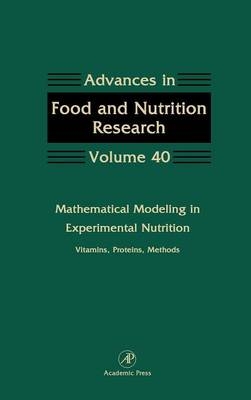
Mathematical Modeling in Experimental Nutrition: Vitamins, Proteins, Methods
Academic Press Inc (Verlag)
978-0-12-016440-0 (ISBN)
- Titel ist leider vergriffen;
keine Neuauflage - Artikel merken
This book developed from a series of conferences to facilitate the application of mathematical modeling to experimental nutrition. As nutrition science moves from prevention of gross deficiencies to identifying requirements for optimum long term health, more sophisticated methods of nutritional assessment will be needed. Collection and evaluation of kinetic data may be one such method.
This books opens with chapters giving specific examples of the application of modeling techniques to vitamin A, carotenoids, folate, vitamin b-6, glycogen phosphorylase, transthyretin, amino acids, and energy metabolism. Obtaining kinetic data on internal processes is a major challenge; therefore, the text includes chapters on the use of microdialysis and ultrafiltration, use of membrane vesicles, and culture of mammary tissue.
Many of the authors use the Simulation, Analysis and Modeling program which allows compartmental models to be described without specifying the required differential equations. The final sections of the book, however, present some more mathematical descriptions of physiological processes, including bioperiodicity, metabolic control, and membrane transport; discussions of some computational aspects of modeling such as parameter distributions, linear integrators and identifiability; and alternative mathematical approaches such as neural networks and graph theory.
Dr. Coburn is director of the Biochemistry Department and Clincial Laboratory at the Fort Wayne State Developmental Center and professor ofchemistry at Indiana University–Purdue University at Fort Wayne. His undergraduate training was in agriculture at Rutgers University and his graduate training was in biochemistry at Purdue University. He is a diplomat of the American Board of Clinical Chemistry. His research has focused on the use of stable and radioactive tracers to evaluate the routes, rates, and regulation of vitamin B-6 metabolism. He has published numerous articles and reviews as well as a monograph, Chemistry and Metabolismof 4'-Deoxypyridoxine (CRC Press, 1981).
Vitamin Metabolism: M.H. Green and J.B. Green, Quantitative and Conceptual Contributions of Mathematical Modeling to Current Views on Vitamin A Metabolism, Biochemistry, and Nutrition. J.A. Novotny, L.A. Zech, H.C. Furr, S.R. Dieker, and A.J. Clifford, Mathematical Modeling in Nutrition: Constructing a Physiologic Compartmental Model of the Dynamics of Beta-Carotene Metabolism. J.E. Swanson, K.J. Goodman, R.S. Parker, and Y.-y. Wang, Experimental Approaches to the Study of Beta-Carotene Metabolism: Potential of a 13C Tracer Approach to Modeling Beta-Carotene Kinetics in Humans. J.F. Gregory, III, and K.C. Scott, Modeling of Folate Metabolism. B.-F. Lin, J.-S. Kim, J.-C. Hsu, C. Osborne, K.Lowe, T. Garrow, and B. Shane, Molecular Biology in Nutrition Research: Modeling of Folate Metabolism. S.P. Coburn, Modeling Vitamin B6 Metabolism. Protein and Amino Acid Metabolism: R.J. Beynon, C. Bartram, A. Flannery, R.P. Evershed,P. Hopkins, V. Toescu, J. Phoenix, and R.H.T. Edwards, Interrelationships between Metabolism of Glycogen Phosphorylase and Pyridoxal Phosphate: Implications in McArdle's Disease. D. Hanes, L. Zech, J. Murrell, and M.D. Benson, Metabolism of Normal and Met30 Transthyretin. M.J. Gahl, T.D. Crenshaw, N.J. Benevenga, and M.D. Finke, Use of a Four Parameter Logistic Equation and Parameter Sharing to Evaluate Animal Responses to Graded Levels of Nitrogen or Amino Acids. Energy Metabolism: W.W. Wong, Total Energy Expenditure of Free-Living Humans Can Be Estimated with the Doubly Labeled Water Method. Methods for Obtaining Kinetic Data: E.M. Janle and P.T. Kissinger, Microdialysis and Ultrafiltration. P. Proulx, Membrane Vesicles. J.D. Turner, A. Delaquis, and C. Malo, Culture of Mammary Tissue: Glucose Transport Processes. Simulating Complex Metabolic Processes: L.P. Mercer and D.S. Kelley, Analysis of Bioperiodicity in Physiological Responses. A.R. Shultz, Nutrient–Response: A"Top Down"Approach to Metabolic Control. R.B. King, Modeling Membrane Transport. Computational Aspects of Modeling: W.F. Beltz, Estimation and Use of Kinetic Parameter Distribution in Metabolism and Nutrition. R.C. Boston, T. McNabb, P.C. Greif, and L.A. Zech, Essential Numerical Supports for Kinetic Modeling Software: Linear Integrators. J.A. Jacquez, Indentifiability. S.I. Sayegh, Dynamic Systems and Neural Networks: Modeling in Physiology and Medicine. H. Zhang and Z. Zhang, Graph Theoretical Methods for Physiologically Based Modeling. Chapter References. Index
| Erscheint lt. Verlag | 2.12.1996 |
|---|---|
| Reihe/Serie | Advances in Food and Nutrition Research |
| Mitarbeit |
Herausgeber (Serie): Steve Taylor |
| Verlagsort | San Diego |
| Sprache | englisch |
| Maße | 152 x 229 mm |
| Gewicht | 660 g |
| Themenwelt | Sachbuch/Ratgeber ► Essen / Trinken |
| Mathematik / Informatik ► Mathematik ► Angewandte Mathematik | |
| Medizin / Pharmazie ► Gesundheitsfachberufe ► Diätassistenz / Ernährungsberatung | |
| ISBN-10 | 0-12-016440-X / 012016440X |
| ISBN-13 | 978-0-12-016440-0 / 9780120164400 |
| Zustand | Neuware |
| Haben Sie eine Frage zum Produkt? |
aus dem Bereich


